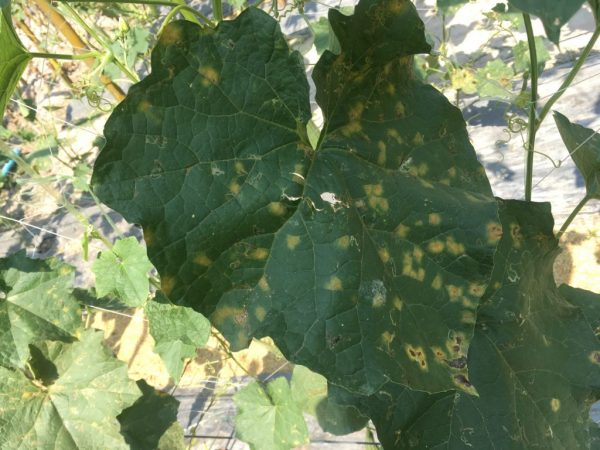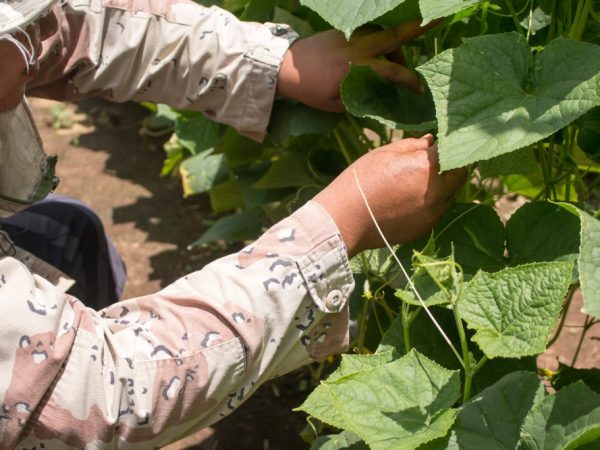Treatment of white rot on cucumbers
White rot is a disease that affects many crops. Cucumbers are no exception, so every gardener should know how to deal with such an enemy. What is white rot on cucumbers, how is it dangerous and what methods of dealing with it exist?

Treatment of white rot on cucumbers
Characteristics of the disease
The causative agent of this disease is sclerotia, a type of fungal infection that affects the leaves, stems and other parts of the plant. The frequency and rate of development of this ailment is so high that every gardener tries to protect cucumbers from its appearance.
Causes of occurrence
The reproduction of pathogenic organisms is associated with high soil moisture, as well as with a decrease in temperature, especially in a greenhouse. Dampness and cold are an ideal environment for the development of the disease, which manifests itself on the plant in the form of spores, multiplies and begins destructive actions in relation to seedlings. Just one dispute is enough to trigger the destructive mechanism for the development of the disease.
The trouble is that if the seedlings are located close, the infection of all nearby plants is inevitable. For this reason, cucumber bushes are never placed too close.
The danger
The insidiousness of the disease is that:
- the infection affects plants of any age: from the youngest seedlings to those that have already begun to bear fruit, as a result, the yield of plants drops sharply;
- fungi live in the soil for a long time;
- sclerotia are often inadvertently brought into the ground with new soil and water: spores penetrate even through gardening tools, if they have previously worked on a territory infected with fungi;
- if the disease has developed, even at first glance high-quality fruits are subject to rapid decay, and the plant itself infects the neighbors in the garden and dies.
Symptoms
The fungus has several stages of development, which are usually known to all experienced farmers. At first, you will notice small damp spots appearing from the root to the top. After that, a growth is noted that resembles white cotton wool. Further, the formation of mucus is noticeable, which drips onto the seedlings nearby and infects it.
The next stage is black sclerotia, similar to dense peas. They develop throughout the plant, then the process of rotting seedlings begins. Everything is affected: leaves, stems, root system. If this happened at the development stage, the seedlings will die without yielding a crop. If the white rot on cucumbers in the greenhouse overtook the bushes at the fruiting stage, the crop has no nutritional value.
Control methods

Treatment should be started as early as possible.
Treatment should be started as early as possible, as it will be much more effective in the early stages.
Onset of the disease
At the first signs of sclerotia, watering is stopped and the moisture level in the greenhouse is reduced as much as possible. To solve the problem with the fungus, antiseptics such as Oxychom and Topaz are required.10 g of Oxychoma is diluted in 5 liters of warm water and sprayed with infected bushes. If Topaz is preferable, 1 ampoule diluted in 10 liters of water is sufficient. The resulting solution is sprayed on places where white rot has penetrated.
You can also use folk methods. One of these options can be milk whey, which contains substances that can fight pathogenic spores on cucumbers. To do this, it is enough to prepare a solution where 3.5 liters of water are mixed with 1.5 liters of whey. A half teaspoon of copper sulfate is also added there.
After processing the bushes, be sure to ventilate the greenhouse. It is important that the air temperature does not drop below 18 ° C, otherwise the result of the struggle will be far from the desired one. If the weather does not permit, the cucumbers are covered with an additional cloth or foil. After 7 days, the seedlings are processed again.
Middle stage
If white rot on cucumbers develops confidently and manages to infect a part of the plant, it can still be saved, but more serious measures are required.
First of all, the affected area must be removed with garden shears. The cut site is treated with crushed coal lime, not forgetting about the root part. Further, foliar feeding of the plant is required, for which urea (10 g), zinc sulfate (1 g) and copper sulfate (2 g) are mixed in warm water.
This method of control allows you to prevent the further development of the disease and its destructive effect on the rest of the seedlings and bushes.
If the disease has already developed
If the sclerotia has managed to multiply throughout the entire part of the plant, it will not be possible to save the bush. Treatment at this stage turns out to be ineffective, so the only correct solution would be to remove the bush along with the soil. This measure helps prevent the death of nearby plants.
Preventive actions
To avoid the appearance of an ailment, preventive measures are needed that can reduce infection of seedlings to a minimum. They are quite simple and do not require special financial costs:
- first of all, the soil is treated with high quality before planting cucumbers - calcination would be an ideal option;
- immediately before planting, a solution of potassium permanganate is poured into each well in a proportion of 5 g per 10 l of water;
- bushes are planted at a distance from each other;
- plant residues from previous plantings are removed.
In order to prevent the re-development of the cucumber disease, it is imperative to control the humidity in the greenhouse, remember to air it regularly, and promptly remove fruits and stems that have rotted. Also, before flowering, use Planriz (0.01%). This drug is harmless to humans and animals, it is designed to increase the immunity and vitality of cucumbers and other crops. With regular care and timely treatment, the harvest will be the envy of everyone, both in terms of taste and the amount of vegetables harvested.


